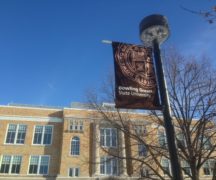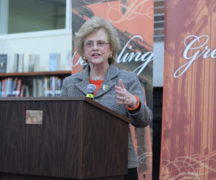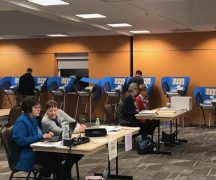By DAVID DUPONT
BG Independent News
University students are going hungry.
How many attend Bowling Green State University is hard to ascertain — there’s a stigma associated with people admitting they don’t have enough food, and the resources.
BGSU officials have put a focus on the problem, and finding ways to address it.
Dr. Sandy Earle, the wife of President Rodney Rogers, has taken it on as part of her duties.

2017 MLK Day food drive
When her husband was appointed president early this year she was told, she had power. She decided, she said, she wanted to use that power for the good of students.
“I want students to have everything they need to be successful,” she said in a recent interview. “I don’t want them worrying about what they’re going to eat. I don’t want them worrying about where they’e going to sleep. I’m worried about their mental health,” she said. “I want them focused on their exams and papers. … They need to be worried about what they’re supposed to be learning. They need to be growing in positive ways. … You need to be nourished to do well in college.”
Earle, who has a doctorate in pharmacology and has taught at the University of Findlay, said that food insecurity is a good place to start those efforts.
V. Jane Rosser, the director of the Center for Community and Civic Engagement, appreciates the involvement of the university’s first lady in the efforts.
Earle’s involvement helps bring attention to the issues. “I also appreciate that it’s informed by her experience on the faculty of the University of Findlay.”
Earle said that a study of students from 66 institutions that drew more than 40,000 responses found that 36 percent were suffering from some level of food insecurity. On the lower level that’s only being able to afford to eat Ramen noodles, at its more extreme it’s not having enough to eat.
The national survey, she said, covered a range of schools from two-year colleges to universities, and the findings varied with more students at community colleges reporting not having enough to eat.
Carrie Hamady, who directs the undergraduate dietetics program, said at BGSU the problem affects some groups more than others.
Those include students living off campus, especially if they have children. It includes veterans, and it includes international students and graduate students.
It may also include university employees, Rosser said.
Students who are hungry find it hard to study, Hamady said. They are also less likely to attend extra sessions that would help them understand the class work better or make connections in their field.
Students who are food insecure, Earle said, are more likely to be depressed. They also graduate at a lower rate and are more likely to drop out of courses.
She was careful not to say the food insecurity causing these other problems, but the correlation is strong.
Earle said she felt the problem was increasing. Given the demand for a college education more students are coming from families that experience food insecurity. That follows them to campus.
Recipients of SNAP benefits (Food Stamps) often are not able to stretch their benefits through the month.
Part of helping students is offering training on how to do that, and how to access nutritional foods, Hamady said.
The university has several initiatives in place. There’s a monthly mobile food pantry that visits campus.
This summer a community garden was planted near the Fine Arts Center. The two raised beds put in with the help of Bostdorff’s Greenhouse are starting to produce tomatoes, herbs, radishes, lettuce and cucumbers, though the beds went in mid-summer.
Earle said she hopes students can get an earlier start on the garden next spring.
Through Chartwells, which runs dining services, a Falcon swipes program is available.
Through this program, students can donate the swipes for meals they don’t use. Students in need then get cards that enable them to eat at the dining halls.
Rosser said Chartwells will even provide swipes during the semester when none are donated in anticipation of more being available at the end of the semester.
Chartwells also works with students to bring excess food from the dining halls up to the Cherry Street Mission in Toledo.
“It’s not just a campus initiative, but it’s a community initiative as well,” Hamady said.
Rosser said that many of the students in need live in the community, and use the resources of local food pantries, many of which are located in neighborhoods with many student residents.
It’s important to coordinate with their efforts.
One way is to teach fraternities, sororities, and other groups how to have “purposeful food drive,” Rosser said.
The focus is on collecting the kind of goods the pantries need and can use.
Making students aware that help is available “is the biggest thing,” Hamady said. “It’s raising awareness that the community as well as campus is there for them. …It’s letting them know we’re here to help you.”
That has to be a multi-layered approach involving academic advisors, the counseling center, student affairs staff, and faculty.
They are trained to spot the signs that someone is struggling with having enough foods, or a professor could include a blurb on the syllabus letting them know where they can get help.
Efforts are not only directed at meeting the immediate needs, but also offer students a chance to become engaged in their communities.
That develops values, Hamady said, that students will carry with them after they graduate.
It also, she said, offers opportunities for research.
She has a graduate student conducting follow up interviews with some of those who filled out the food insecurity survey.
The aim is to make sure they understood the questions and answered them appropriately. This will help university officials get a better handle on the scope of the problem, and then determine other ways to address it.





